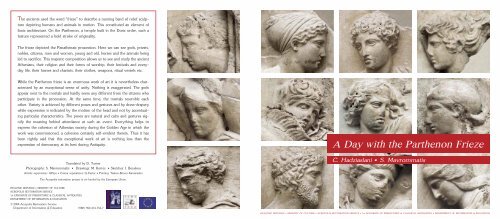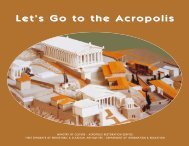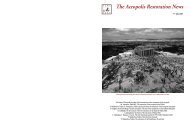A Day with the Parthenon Frieze
A Day with the Parthenon Frieze
A Day with the Parthenon Frieze
Create successful ePaper yourself
Turn your PDF publications into a flip-book with our unique Google optimized e-Paper software.
The ancients used <strong>the</strong> word “frieze” to describe a running band of relief sculpturedepicting humans and animals in motion. This constituted an element ofIonic architecture. On <strong>the</strong> Par<strong>the</strong>non, a temple built in <strong>the</strong> Doric order, such afeature represented a bold stroke of originality.The frieze depicted <strong>the</strong> Pana<strong>the</strong>naic procession. Here we can see gods, priests,nobles, citizens, men and women, young and old, horses and <strong>the</strong> animals beingled to sacrifice. This majestic composition allows us to see and study <strong>the</strong> ancientA<strong>the</strong>nians, <strong>the</strong>ir religion and <strong>the</strong>ir forms of worship, <strong>the</strong>ir festivals and everydaylife, <strong>the</strong>ir horses and chariots, <strong>the</strong>ir clo<strong>the</strong>s, weapons, ritual vessels etc.While <strong>the</strong> Par<strong>the</strong>non frieze is an enormous work of art it is never<strong>the</strong>less characterizedby an exceptional sense of unity. Nothing is exaggerated. The godsappear next to <strong>the</strong> mortals and hardly seem any different from <strong>the</strong> citizens whoparticipate in <strong>the</strong> procession. At <strong>the</strong> same time, <strong>the</strong> mortals resemble eacho<strong>the</strong>r. Variety is achieved by different poses and gestures and by dress-draperywhile expression is indicated by <strong>the</strong> motion of <strong>the</strong> head and not by accentuatingparticular characteristics. The poses are natural and calm and gestures signify<strong>the</strong> meaning behind attendance at such an event. Everything helps toexpress <strong>the</strong> cohesion of A<strong>the</strong>nian society during <strong>the</strong> Golden Age in which <strong>the</strong>work was commissioned, a cohesion certainly self-evident <strong>the</strong>rein. Thus it hasbeen rightly said that this exceptional work of art is nothing less than <strong>the</strong>expression of democracy at its best during Antiquity.Translated by D. TurnerPhotographs: S. Mavrommatis ñ Drawings: M. Korres ñ Sketches: I. BenekouArtistic supervision: AltSys ñ Colour separations: Q-Factor ñ Printing: Tsakos-Benou-KamaradouA <strong>Day</strong> <strong>with</strong> <strong>the</strong> Par<strong>the</strong>non <strong>Frieze</strong>C. Hadziaslani ñ S. MavrommatisThe Acropolis restoration project is co-funded by <strong>the</strong> European Union.HELLENIC REPUBLIC ñ MINISTRY OF CULTUREACROPOLIS RESTORATION SERVICE1st EPHORATE OF PREHISTORIC & CLASSICAL ANTIQUITIESDEPARTMENT OF INFORMATION & EDUCATION© 2004 Acropolis Restoration ServiceDepartment of Information & EducationISBN: 960-214-754-7★★★★★★★★★★★★ ★★★HELLENIC REPUBLIC ñ MINISTRY OF CULTURE ñ ACROPOLIS RESTORATION SERVICE ñ 1st EPHORATE OF PREHISTORIC & CLASSICAL ANTIQUITIES ñ DEPARTMENT OF INFORMATION & EDUCATION
The Par<strong>the</strong>non and its Sculptural DecorationThe Par<strong>the</strong>non, <strong>the</strong> great temple that dominates <strong>the</strong> Acropolis of A<strong>the</strong>ns, was built by <strong>the</strong> leading statesmanPericles, in honour of <strong>the</strong> goddess A<strong>the</strong>na in <strong>the</strong> middle of <strong>the</strong> 5th century B.C. and was completedin only nine years. Marble from <strong>the</strong> quarries of Mt. Penteli in Attica was used throughout in <strong>the</strong>temple’s construction. The temple is famous for its proportions, optical refinements, structural perfectionand its sculptural decoration. Today, despite its ruinous state, it still evokes universal wonder and,perhaps more than any o<strong>the</strong>r building, manages to unite a host of different values to represent <strong>the</strong> spirit and achievementof <strong>the</strong> Classical era of ancient Greek civilization.What provided <strong>the</strong> Par<strong>the</strong>non <strong>with</strong> special artistic distinction during antiquity was its sculptural decoration, of a richnessand variety not seen till that time. One could see both devotional and narrative scenes in <strong>the</strong> reliefs on <strong>the</strong> great temple.Never<strong>the</strong>less, it is clear that <strong>the</strong>se provided <strong>the</strong> opportunity for magnificent artistic achievement as well as a vehiclefor political ideas.In <strong>the</strong> temple’s interior <strong>the</strong>re rose <strong>the</strong> great statue of <strong>the</strong> goddess A<strong>the</strong>na, 13.5 metres high, made of gold and ivory, <strong>the</strong>work of Pheidias. Of this nothing survives. Only a much smaller Roman marble copy gives us an idea of what it lookedlike. The goddess was shown standing upright, wearing a long peplos and a breastplate embossed <strong>with</strong> a depiction of <strong>the</strong>head of <strong>the</strong> Medusa. On her head she wore an ornate helmet decorated <strong>with</strong> mythological animals. Her right hand helda statue of Victory (Nike) and her left a shield and spear. The outer surface of <strong>the</strong> shield was decorated <strong>with</strong> a relief depictionof <strong>the</strong> battle between Greeks and Amazons, and <strong>the</strong> inner <strong>with</strong> an inscribed depiction of <strong>the</strong> battle between Godsand Giants (Gigantomachy). The soles of her sandals were decorated <strong>with</strong> relief depictions of <strong>the</strong> battle of <strong>the</strong> Lapiths andCentaurs (Centauromachy). Finally, <strong>the</strong> base of <strong>the</strong> statue was decorated <strong>with</strong> a reliefdepiction of <strong>the</strong> birth of Pandora.Large-scale compositions, some 3.20 x 25 metres, adorned <strong>the</strong> two triangularpediments on <strong>the</strong> east and west façade of <strong>the</strong> temple. Theselarger than life-size sculptures were executed in <strong>the</strong> round and depictedtwo A<strong>the</strong>nian myths associated <strong>with</strong> <strong>the</strong> goddess: The east pediment,above <strong>the</strong> entrance to <strong>the</strong> temple, depicted <strong>the</strong> birth of A<strong>the</strong>na in <strong>the</strong>presence of all <strong>the</strong> Olympian gods, while <strong>the</strong> west pediment showed herstruggle <strong>with</strong> Poseidon in <strong>the</strong> presence of <strong>the</strong> mythical lords of A<strong>the</strong>ns.Many of <strong>the</strong>se pedimental statues have been preserved.Drawing: M. KorresThe metopes consist of large square plaques which, toge<strong>the</strong>r <strong>with</strong> <strong>the</strong> triglyphs, form <strong>the</strong> horizontal tier (diazoma) oftemples of <strong>the</strong> Doric order. On <strong>the</strong> Par<strong>the</strong>non, <strong>the</strong>re were 92 metopes, each approx. 1.30 x 1.30 metres, which for <strong>the</strong>first time were completely covered <strong>with</strong> relief depictions. These included very ancient myths of <strong>the</strong> Gigantomachy on<strong>the</strong> east side, <strong>the</strong> battle between Greeks and Amazons on <strong>the</strong> west, <strong>the</strong> Centauromachy on <strong>the</strong> south and <strong>the</strong> TrojanWar on <strong>the</strong> north. Some metopes are preserved in <strong>the</strong>ir original location, o<strong>the</strong>rs are in museums.The Ionic frieze ran outside <strong>the</strong> upper part of <strong>the</strong> cella and along <strong>the</strong> upper part of <strong>the</strong> inner colonnades, east towest. This was, once again, an innovation for Doric order temples. Over a length of 160 metres we see <strong>the</strong> greatfestival of <strong>the</strong> A<strong>the</strong>nians in honour of <strong>the</strong> goddess A<strong>the</strong>na, <strong>the</strong> so-called Pana<strong>the</strong>naea. This unique composition was,in contrast to <strong>the</strong> o<strong>the</strong>r sculptures, carved on site and in low relief. A significant part of <strong>the</strong> frieze is preserved todayin museums.The temple’s sculptural decoration was completed <strong>with</strong> acroteria affixed to <strong>the</strong> three corners of <strong>the</strong>pediments. These included statues of Nike at <strong>the</strong> corners and an<strong>the</strong>mia (foliate motifs) in <strong>the</strong> middle.Lion-head spouts also existed at <strong>the</strong> end of <strong>the</strong> long colonnades, two of which can still beseen in <strong>the</strong>ir original location.Naturally, <strong>the</strong> construction of all this sculpture was undertaken by many sculptors,all under <strong>the</strong> guidance of a great artist who co-ordinated <strong>the</strong> wholework. Written sources indicate that this was Pheidias, a personal friendof Pericles. It was he who formulated <strong>the</strong> general outline of <strong>the</strong>se largecompositions and itwas he who executed<strong>the</strong> most importantsculptures<strong>with</strong> his own hand.Observe <strong>the</strong> difference between <strong>the</strong> three-dimensional statues of <strong>the</strong> pediments,<strong>the</strong> high relief of <strong>the</strong> metopes and <strong>the</strong> low relief of <strong>the</strong> frieze.
The Pana<strong>the</strong>naea, <strong>the</strong> Great Festival of A<strong>the</strong>naThe first month of <strong>the</strong> A<strong>the</strong>nian year was called Hekatombaeon. According to tradition, <strong>the</strong> goddesspatronof <strong>the</strong> city celebrated her birthday on <strong>the</strong> 28th of that month (somewhere near <strong>the</strong> 15th ofAugust). It was around that date that <strong>the</strong> Pana<strong>the</strong>naea, <strong>the</strong> great festival of ancient A<strong>the</strong>ns, was celebrated.This festival was of great antiquity but was reorganized in 556 B.C. on <strong>the</strong> initiative ofPeisistratos who introduced its spectacular celebration every four years: <strong>the</strong> Great Pana<strong>the</strong>naea. Thistook place over several days and included various events: artistic and athletic competitions as well as <strong>the</strong> greatPana<strong>the</strong>naic procession. The procession culminated in <strong>the</strong> handing over of <strong>the</strong> “peplos”, a new robe, <strong>the</strong> gift of <strong>the</strong>A<strong>the</strong>nians to <strong>the</strong> “Diipetes Xoanon”, <strong>the</strong> ancient heaven-sent wooden cult statue of A<strong>the</strong>na that originally stood in <strong>the</strong>so called Earlier Temple and was <strong>the</strong>n transferred to <strong>the</strong> Erech<strong>the</strong>ion.Artistic competitions included music (avloi and guitar) and rhapsodycontests, i.e. where poems were read out.The athletic contests included: <strong>the</strong> “Gymnic Games” (track, wrestling,boxing, jumping, disc and javelin throwing), Horse Races, ChariotRaces (<strong>with</strong> two horses, <strong>with</strong> four horses, and <strong>the</strong> “Apobasia” contest,described below), Boat Races. Finally, <strong>the</strong>re were <strong>the</strong> contests whichinvolved local tradition: <strong>the</strong> “Evandria” which required strength andskill, <strong>the</strong> “Pyrrhic Dance” which involved armed warriors as dancers;according to tradition this had first been danced by A<strong>the</strong>na to celebrate<strong>the</strong> victory of <strong>the</strong> Olympian gods over <strong>the</strong> Titans. Ano<strong>the</strong>r contest was<strong>the</strong> “Lambadidromia” (Torch Race): It involved forty runners, one after<strong>the</strong> o<strong>the</strong>r running at night <strong>with</strong> <strong>the</strong>ir torches, bringing <strong>the</strong> flame from<strong>the</strong> altar of Eros at <strong>the</strong> Academy to <strong>the</strong> Acropolis. The victor lit <strong>the</strong>flame at <strong>the</strong> altar of A<strong>the</strong>na and <strong>the</strong> holy ritual of sacrifice at <strong>the</strong>Pana<strong>the</strong>naea began.The prizes given to <strong>the</strong> victors were vases of outstanding craftsmanship,<strong>the</strong> so-called Pana<strong>the</strong>naic Amphorae, filled <strong>with</strong> olive-oil (36 kilosE V, British Museumof it). Depicted on one side was A<strong>the</strong>na as a warrior goddess and on <strong>the</strong> o<strong>the</strong>r <strong>the</strong> competition for which <strong>the</strong> amphorawas awarded. The first prize averaged at 50-70 amphorae, while <strong>the</strong> victor of <strong>the</strong> chariot races won 140 amphorae,namely 5 tons of olive-oil <strong>with</strong> a value of about 1680 ancient drachmae. Note, that one drachma represented a normaldaily wage.On <strong>the</strong> 28th of Hekatombaeon, on <strong>the</strong> goddess’ birthday, <strong>the</strong>re tookplace <strong>the</strong> great procession culminating in <strong>the</strong> offering of <strong>the</strong> peplosto her. At daybreak, <strong>the</strong> procession began from a special buildingknown as <strong>the</strong> “Pompeion” (Procession-Hall) in <strong>the</strong> Kerameikos, followed<strong>the</strong> Pana<strong>the</strong>naic Way, cut through <strong>the</strong> Agora and wound itsway up <strong>the</strong> Acropolis. The peplos, which had been woven <strong>with</strong>depictions from <strong>the</strong> Gigantomachy by <strong>the</strong> “Ergastines”, girls of noblefamilies chosen specifically for this purpose, was suspended on <strong>the</strong>mast of a ship which moved on wheels. The ship stopped on levelland near <strong>the</strong> Areopagus and <strong>the</strong> peplos was carriedby <strong>the</strong> Ergastines from <strong>the</strong> entrance to <strong>the</strong>Acropolis up to <strong>the</strong> temple.Ten organizers called “Athlo<strong>the</strong>tai”were responsiblefor all <strong>the</strong> events during <strong>the</strong>many days of <strong>the</strong> Festival.E VII, The Louvre MuseumWhy do we think that <strong>the</strong> frieze of <strong>the</strong> Par<strong>the</strong>non depicts <strong>the</strong>Pana<strong>the</strong>naic procession?
The Composition of <strong>the</strong> Par<strong>the</strong>non <strong>Frieze</strong>The manner in which Pheidias planned and placed <strong>the</strong> procession along <strong>the</strong> four sides of <strong>the</strong> temple is initself a work of genius. From <strong>the</strong> south-west corner of <strong>the</strong> temple <strong>the</strong> procession began in two groups,each going in different directions. One went along <strong>the</strong> west and north side and <strong>the</strong> o<strong>the</strong>r along <strong>the</strong> southThe Par<strong>the</strong>non frieze is a continuous relief depiction running along <strong>the</strong> top part of <strong>the</strong> outside wall ofside of <strong>the</strong> temple. Both groups included riders, chariots and citizens who had a role to play in <strong>the</strong><strong>the</strong> main temple, <strong>with</strong>in <strong>the</strong> outer colonnade. Its total length was 160 metres while its height wassacrifice. Both parts of <strong>the</strong> procession met on <strong>the</strong> east side of <strong>the</strong>approx. one metre. Rich colors and added metal attachments were used to decorate <strong>the</strong> individual figuresthat stood out against a deep blue ground.N temple above <strong>the</strong> main entrance to <strong>the</strong>Npronaos. There we find <strong>the</strong> depiction of A<strong>the</strong> culmination of <strong>the</strong> festival and of <strong>the</strong>¢The composition consisted of 360 divine and human figures and about 250 animals, mostly horses. Competing groupsBPana<strong>the</strong>naea: <strong>the</strong> presentation of <strong>the</strong> peplos.of riders and charioteers take up most of <strong>the</strong> procession. Then <strong>the</strong>re follows <strong>the</strong> procession of <strong>the</strong> sacrifice <strong>with</strong> animalsBand groups of female and male figures bringing <strong>the</strong> holy ritual vessels for <strong>the</strong> offerings and <strong>the</strong> sacrifice. Depicted in <strong>the</strong>middle of <strong>the</strong> east side, above <strong>the</strong> entrance to <strong>the</strong> temple, is <strong>the</strong> presentation of <strong>the</strong> peplos. To <strong>the</strong> left and right areTry to establish, on <strong>the</strong> basis of <strong>the</strong> way <strong>the</strong> procession is going, which of <strong>the</strong> friezeseated <strong>the</strong> twelve gods. Between <strong>the</strong>m and in <strong>the</strong> procession we also see 10 figures, <strong>the</strong> famous heroes of Attica, <strong>the</strong>blocks below belonged to <strong>the</strong> north and which to <strong>the</strong> south side of <strong>the</strong> frieze.mythical forefa<strong>the</strong>rs of <strong>the</strong> A<strong>the</strong>nians.<strong>Frieze</strong>blocks X, XI, British Museum<strong>Frieze</strong>blocks XLII, XLIII, British Museum
The Presentation of <strong>the</strong> Peplos to <strong>the</strong> Goddess A<strong>the</strong>na and <strong>the</strong> Gods of OlympusDepicted to <strong>the</strong> right and left of <strong>the</strong> central scene are <strong>the</strong> seated godsof Olympus executed <strong>with</strong> exceptional skill. These must have beensculpted by <strong>the</strong> great and famous sculptors of <strong>the</strong> day such asPheidias, Agorakritos and Alkamenes, who all took part in this outstandingproject.How do <strong>the</strong>se figures of <strong>the</strong> deities stand out amongst<strong>the</strong> 360 figures in <strong>the</strong> frieze?Five figures appear in <strong>the</strong> central scene. Three females, two carrying<strong>the</strong> sacred stools (<strong>the</strong> so-called “diphroi”) and a large figure (<strong>the</strong>priestess?) who leads <strong>the</strong>m. A reverent male figure (perhaps <strong>the</strong>Archon-King or a priest) and a boy hold <strong>the</strong> peplos.Which of <strong>the</strong> two receive <strong>the</strong> peplos to present it to <strong>the</strong>goddess A<strong>the</strong>na? Justify your answer.Try to identify <strong>the</strong> deities andjustify your identification. Carefully note <strong>the</strong> hierarchicalposition <strong>the</strong>y have in <strong>the</strong> composition, <strong>the</strong>relationship between <strong>the</strong>m and <strong>the</strong>ir characteristicattributes (or symbols) that <strong>the</strong>y hold and which yourecognize from mythology.
Humans, Horses and Chariots in <strong>the</strong> ProcessionIn <strong>the</strong> procession 345 humans are depicted along <strong>with</strong> about 230 horses. They were carved byvarious sculptors who had to place horses and riders <strong>with</strong>in a space about one metre high, <strong>with</strong><strong>the</strong> result that <strong>the</strong> horses are small of stature compared to <strong>the</strong> humans.No single figure is singled out for special emphasis in <strong>the</strong> procession. The austere profile of <strong>the</strong>faces, which resemble each o<strong>the</strong>r, are imbued <strong>with</strong> ethos, spiritual grace and dignity. A wonderful natural harmonyexists between <strong>the</strong> figures, who are differentiated by <strong>the</strong>ir poses and <strong>the</strong> way <strong>the</strong>y move ra<strong>the</strong>r than byappearance. The classical ideal of art, <strong>the</strong> depiction of beauty, dominates each and every detail of <strong>the</strong> frieze.Clothing does not try to differentiate individual figures. Typically, <strong>the</strong> gods and goddesses are dressed in <strong>the</strong>same way as <strong>the</strong> mortals. Variety, however, is established <strong>with</strong> rich drapery, <strong>the</strong> ease <strong>with</strong> which it covers <strong>the</strong>body and <strong>the</strong> discretion <strong>with</strong> whichweapons are displayed. A few citizensare armed but nowhere do we see anythingthat resembles a military uniform.Weapons simply play <strong>the</strong>ir part in lendingvariety to <strong>the</strong> figures.All <strong>the</strong> horses are depicted in profile.They have finely wrought outlines and<strong>the</strong>ir individual characteristics aredefined by <strong>the</strong> manner in which heads,nostrils, manes and tails have been executed.At <strong>the</strong> same time, <strong>the</strong> axes formedby <strong>the</strong> heads and <strong>the</strong> bodies of <strong>the</strong> horsescreate <strong>the</strong> impression of motion in asplendid composition marked by greatvariety. Some horses appear at rest.O<strong>the</strong>rs are shown <strong>with</strong> <strong>the</strong>ir mastersN XXXIV, Acropolis Museumholding reins, ready to ride. The horsesei<strong>the</strong>r trot or gallop; some compete <strong>with</strong>each o<strong>the</strong>r while o<strong>the</strong>rs appear agitated.Chariot races were amongst <strong>the</strong> ancientPana<strong>the</strong>naic contests. The section depictingchariots in <strong>the</strong> middle of <strong>the</strong> long sidesis fragmentarily preserved due to <strong>the</strong>well-known explosion of A.D. 1687. On<strong>the</strong> north side, where twelve chariots areshown competing, <strong>the</strong> “apobasia” contestis depicted, a contest involving teamscomprising a four-horse chariot, a charioteerand a fully armed warrior. During <strong>the</strong>race, <strong>the</strong> warrior leaps down from and upto <strong>the</strong> chariot while it is moving.N XXIII, Acropolis MuseumOn <strong>the</strong> south side, where ten chariots are depicted,<strong>the</strong> poor state of <strong>the</strong> marbles does not allow usto discern whe<strong>the</strong>r <strong>the</strong> contest involves <strong>the</strong>apobasia contests or a competition between combatchariots.Stationary chariots, chariots just about to move, chariots <strong>with</strong> warriors in <strong>the</strong> act of leaping, andchariots in motion, all can be found on <strong>the</strong> north and south side of <strong>the</strong> frieze. Try to find <strong>the</strong>m.
The Sacrificial Procession to <strong>the</strong> GoddessThe Fate of <strong>the</strong> Par<strong>the</strong>non <strong>Frieze</strong>he ancients honoured <strong>the</strong>ir gods by offering <strong>the</strong>m sacrifices. They followed special rituals and usedsacred vessels. During <strong>the</strong> sacred rituals, libations of wine were offered to <strong>the</strong> gods along <strong>with</strong> <strong>the</strong> firstfruits and animal sacrifices. Those parts of <strong>the</strong> animal sacrifice not eaten were offered to <strong>the</strong> gods andburnt on an altar. The remaining meat was distributed to <strong>the</strong> A<strong>the</strong>nians at <strong>the</strong> celebrations following<strong>the</strong> sacrifices.n antiquity, Pheidias’ frieze remained untouched on <strong>the</strong> walls of <strong>the</strong> Par<strong>the</strong>non. We do not know towhat extent it suffered in <strong>the</strong> great fire of <strong>the</strong> 3rd century A.D. During <strong>the</strong> temple’s transformation intoa Christian church, probably between A.D. 450-500, certain parts of <strong>the</strong> east side were removed. Evenlater, perhaps in <strong>the</strong> 12th century, o<strong>the</strong>r blocks of <strong>the</strong> frieze were removed to allow room for windowsfor <strong>the</strong> church.TIOn <strong>the</strong> long sides of <strong>the</strong> frieze, <strong>the</strong> sacrificial procession is followed by <strong>the</strong> animals to be offered to <strong>the</strong> goddess. On <strong>the</strong>south side we see ten cattle and on <strong>the</strong> north four cattle and four rams <strong>with</strong> <strong>the</strong>ir attendants. There are also groups ofmen carrying trays of offerings, o<strong>the</strong>rs who hold hydrias (large vases <strong>with</strong> water), musicians <strong>with</strong> avloi (pipes) and guitarsand handsome aged men holding olive branches painted in <strong>the</strong> background.The sacrificial processionN II Acropolis Museumcontinues along <strong>the</strong> east sideof <strong>the</strong> frieze, <strong>the</strong> holy part of<strong>the</strong> temple where we see no animalsbut just gods and mortals.This is <strong>the</strong> only side where wesee women, who also hold ritualvessels for <strong>the</strong> sacrifice:wine-jars, vases for <strong>the</strong> libations,censers etc.In 1458, <strong>the</strong> Par<strong>the</strong>non was turned into a mosque. In 1674, <strong>the</strong> painter J. Carrey drew <strong>the</strong> sculptures <strong>with</strong> great accuracy.The most disastrous catastrophe occurred 13 years later in 1687 in <strong>the</strong> Ottoman-Venetian war, during Morosini’scampaign in Attica. The explosion which took place after a Venetian cannonball ignited <strong>the</strong> gunpowder stored in <strong>the</strong>Par<strong>the</strong>non destroyed a great part of <strong>the</strong> frieze on <strong>the</strong> flank walls and irreparable damage was done to blocks, both tothose that stayed in place and those that fell to <strong>the</strong> ground. The road was thus opened to looters.In <strong>the</strong> first years of <strong>the</strong> 19th century, <strong>the</strong> British ambassador to <strong>the</strong> Ottoman Empire, Lord Elgin, violently removedfrom <strong>the</strong> ruined Par<strong>the</strong>non all <strong>the</strong> sculptures he could, including 80 metres of <strong>the</strong> frieze. These are known as <strong>the</strong> ElginMarbles, now in <strong>the</strong> British Museum. They constitute <strong>the</strong> largest group of Classical sculpture that has been preserved.The last part of <strong>the</strong> frieze to remain in its original position was thaton <strong>the</strong> west side, some 20 metres long. Increasingly rapid erosion of<strong>the</strong> marbles due to long exposure to <strong>the</strong> elements necessitated <strong>the</strong>irremoval in 1993 to <strong>the</strong> Acropolis Museum.Try to identify <strong>the</strong> groups in <strong>the</strong>Pana<strong>the</strong>naic procession in <strong>the</strong>parts of <strong>the</strong> frieze now in <strong>the</strong>Acropolis Museum.Note <strong>the</strong> damage and wear sustained by <strong>the</strong> marbles and try to account for <strong>the</strong> reasons.








